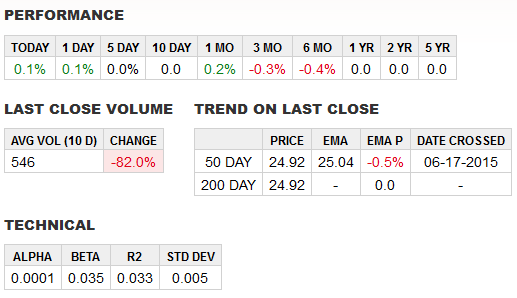Unique Ways to Stick With Bond ETFs as Rates Rise
Plenty of fixed income investors and fund managers are fretting about the impact of higher interest rates and exactly when the Federal Reserve will employ more hawkish measures. That does not mean investors should throw in the towel on fixed income exchange traded funds altogether.
Investors can employ strategies such as the barbell or laddering to protect bond portfolios against rising rates while continuing to generate income.
“Barbell is a figurative term for a strategy of bundling bonds into two, concentrated groups: One chunk focuses on short-term paper, which is safer and carries low yields; the other portion emphasizes longer-term issues that pay out more, and are therefore riskier. Threading the needle can provide advantages over buying the broad market, especially now, when popular indexes look very vulnerable to a Federal Reserve rate increase, which most expect as soon as September,” reports Chris Dieterich for Barron’s.
Investors can access a mix of bond maturities through ETFs, including Guggenheim’s BulletShares lineup, including the Guggenheim BulletShares 2024 Corporate Bond ETF (BSCO) and a group of high-yield options for years up to the Guggenheim BulletShares 2022 High Yield Corporate Bond ETF (BSJM) . [Where Defined-Maturity ETFs Fit Into A Fixed-Income Portfolio]
These defined-maturity bond funds typically buy bonds that mature in the year the ETF will terminate, ensuring that investors can collect the bonds’ face value at maturity, along with a steady income stream along the way. As such, investors are meant to buy-and-hold these securities until maturity. In contrast, a regular bond ETF runs the risk of losing its original principal if interest rates go up, depending on the bond ETF’s effective duration, since the bond funds would buy and sell debt securities to maintain their target strategy.
Using target-date bond funds, an investor could create a bond ladder strategy to help create a portfolio with varying maturity dates. The bonds’ maturity dates are evenly spaced across several years so that the proceeds from maturing bonds may be reinvested at regular intervals. [BulletShares ETFs for Bond Laddering]
As Barron’s notes, DoubleLine Capital’s Jeffrey Gundlach has long been a fan of the bond barbell strategy. Fortunately, there’s an ETF for that. The SPDR DoubleLine Total Return Tactical ETF (TOTL) , Gundlach’s first foray into the ETF space, debuted earlier this year and already has $724.5 million in assets under management. That makes TOTL one of this year’s most successful rookie ETFs.
“TOTL serves up a core fixed-income strategy and seeks to outperform the Barclays U.S. Aggregate Bond Index. At 0.55%, the ETF offers a less expensive way to benefit from Gundlach’s acumen than the 0.73% price tag for the retail share class of his DoubleLine Total Return Fund (DLTNX),” according to Morningstar. [Gundlach’s new Bond ETF]
Gundlach is one of a small amount of bond managers with the temerity to recently state that the Fed will not boost rates this year. TOTL has a modified adjusted duration of 3.88 years. The ETF currently holds 346 bonds, 53.6% of which are mortgage-backed securities.
The PowerShares LadderRite 0-5 Year Corporate Bond Portfolio (LDRI) , which qualifies as a strategic beta fixed income offering, could be a new option for investors concerned about rising interest rates to consider due to the ETF’s lower duration and laddering approach.
LDRI’s “laddering methodology evenly staggers bond maturities so that they occur on regular intervals, providing an efficient balance between risk and return, which may help investors manage volatility during a period of rising interest rates,” according to PowerShares.
PowerShares LadderRite 0-5 Year Corporate Bond Portfolio

